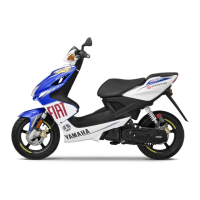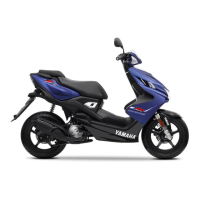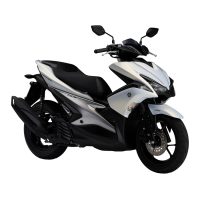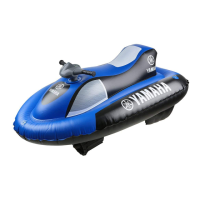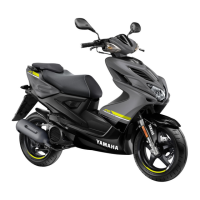
Do you have a question about the Yamaha Aerox R NS50F and is the answer not in the manual?
As the owner, you are responsible for safe and proper operation of your scooter.
Perform pre-operation checks for safe condition. Inspecting/maintaining properly increases safety.
Use a safety helmet, face shield/goggles, and protective clothing to prevent injuries.
Engine exhaust contains deadly carbon monoxide. Avoid running the engine in enclosed or poorly ventilated areas.
Accessories/cargo affect stability. Use caution, keep weight low and close to the center. Max load 182 kg.
Shows handlebar controls and dashboard instruments with numbered labels and page references.
Controls ignition, lighting, and steering lock. Explains ON, OFF, and LOCK positions.
Step-by-step instructions on how to lock and unlock the steering mechanism.
Explains various indicator and warning lights on the dashboard.
Displays speed, clock, odometer, fuel gauge, and indicators. Performs self-test on startup.
Details self-diagnosis system and functions of left/right handlebar switches.
Details front/rear brake levers and the start switch operation.
Instructions for fuel tank cap and safety precautions for refueling.
Step-by-step guide for starting the engine when cold. Includes warnings about lean angle sensor.
How to move the scooter off the centerstand, adjust mirrors, and signal for takeoff.
Proper braking techniques, including warnings for wet roads and slippery surfaces.
Crucial period for engine life. Avoid excessive load and full throttle for the first 1000 km.
Safe parking procedures. Avoid hot exhaust areas, slopes, and flammable materials.
Comprehensive chart detailing maintenance tasks and intervals for various components.
Procedure to remove, check, and install the spark plug for engine condition analysis.
Instructions for checking and changing engine oil, and cleaning the oil strainer.
Specifies the recommended engine oil grade and quantity for the vehicle.
Procedures for checking and changing the final transmission oil, including specifications.
How to check coolant level and add coolant if low. Includes warnings and notices.
How to check and adjust tire pressure based on load conditions.
How to check brake pad wear using the indicator groove or lining thickness.
How to check the brake fluid level in the reservoir and replenish if necessary.
Troubleshooting charts for common starting issues like fuel, battery, ignition, and compression.
How to diagnose and address engine overheating, including coolant checks.

